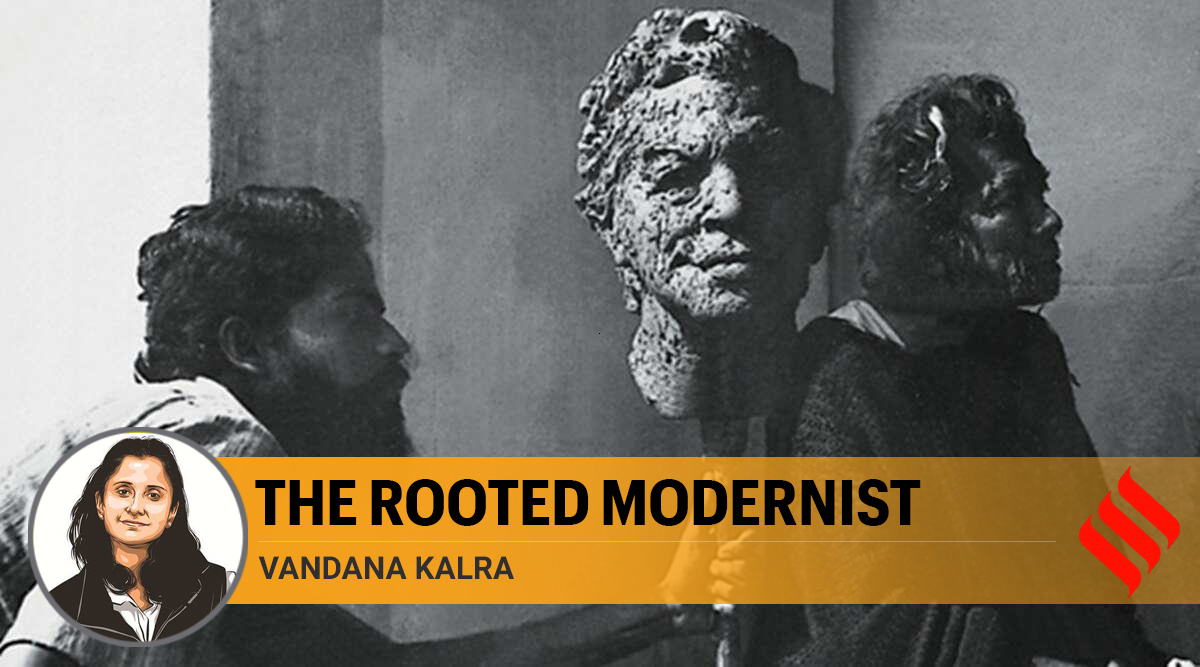 At a time when art in India was largely centred on the British aesthetic and realism, Baij sought a language that merged social commitment and traditionalism with cubism and abstraction
At a time when art in India was largely centred on the British aesthetic and realism, Baij sought a language that merged social commitment and traditionalism with cubism and abstractionThe rather grainy video of the documentary Ramkinkar Baij: A Personality Study has the pioneering modernist dressed in his trademark Chinese straw hat and white bush shirt, being followed by filmmaker Ritwik Ghatak and his crew. He seems oblivious to their presence through most of the filming, sketching profusely even when in conversation with Ghatak. The artist tells him how he uses his larger oil paintings to prevent the damaged roof of his home from leaking when it rains.
Shot in Santiniketan in July 1975, the documentary remained incomplete as Ghatak passed away six months later. Nonetheless, it offers a glimpse into the persona of the enigmatic and eccentric genius who is now considered to be one of India’s earliest modernist sculptors. His means were still meagre when the Padma Bhushan awardee died 40 years ago, on August 2, 1980, and it is perhaps only in the last two decades that his achievements and contribution to Indian art and modernism are being recognised.
At a time when art in India was largely centred on the British aesthetic and realism, Baij sought a language that merged social commitment and traditionalism with cubism and abstraction. Though he explored western approaches, his art was rooted in India — in the red soil of Birbhum and the tribal inhabitants of the region, the Santhals, whose simplicity and resilience he celebrated in two of his most iconic sculptures — Santhal Family (1938) and Mill Call (1956). The former is considered to be the first public modernist sculpture in India, and the latter is reportedly the last work made by Baij using the technique of throwing concrete inside the armature.

Born into a family of barbers in Bankura, Baij had grown up admiring the terracotta sculptures of the Bishnupur temples and the idol makers in the region. An active participant in the Non-Cooperation movement of 1921, upon seeing Baij’s portraits of national leaders, Ramananda Chattopadhyay, editor of the Kolkata-based magazine, Modern Review, had suggested that he learn art at Rabindranath Tagore’s Visva Bharati. It was here that Baij truly discovered himself. While Tagore and Nandalal Bose were his teachers, his peers included Ramendranath Chakraborty and Binode Behari Mukherjee. After seeing his first environmental sculpture in cement-concrete, Sujata, in 1935, Tagore reportedly said that he be allowed to sculpt as he wanted across the campus.
The non-conformist indeed believed in the existence of limitless possibilities. He experimented with medium and subjects alike, from evocative and spontaneous watercolours, to producing arguably India’s first abstract outdoor sculpture, Lamp Stand. For oil paintings, he would replace expensive canvases with bedsheets and gunny cloths and thinned local packet colours with linseed oil. If there were no iron rods to create a frame for sculptures, he would turn to the humble bamboo sticks.
The artist shared a deep relationship with the communities around him, who were his protagonists as well as audience. His students recall how when their teacher “Kinkar da” presented plays of William Shakespeare in the Kala Bhavan campus, the local Santhal villagers would be seated before in rapt attention.
Accustomed to autonomy while pursuing his creative ambitions, rather, unfortunately, his unconventional sensibilities were not appreciated and accepted by all. Indifferent to fame and worldly comforts and inept in money matters, he far exceeded the estimated time and budget while working on the seminal Yaksha-Yakshi statues guarding the doors of the RBI building in Delhi. The humongous pieces of Shivalik sandstone used to make them were famously transported in special wagons from Kangra valley’s Baijnath to Delhi.
As recently as 2017, his Gandhi statue in Assam was in midst of a controversy when a politician stated that it should be replaced as it presented a “distorted image” of Gandhi. The immediate backlash was similar to one in 1979, when a minister in the West Bengal government suggested that Baij’s Tagore bust at Balatonfüred in Hungary should be replaced since it didn’t “look like” the Nobel Laureate. Responding to him, a rather nonchalant Baij reportedly stated: “Let them smash it, who cares? I didn’t ask them to install it.”
It was Tagore’s words that he had accepted as his command. “When you observe something, grab it like a tiger by the nape of the neck. And then, never look back. Those were his last words to me,” the artist shared with Ghatak.
This article first appeared in the print edition on August 20, 2020 under the title ‘The Rooted Modernist’. vandana.kalra@expressindia.com